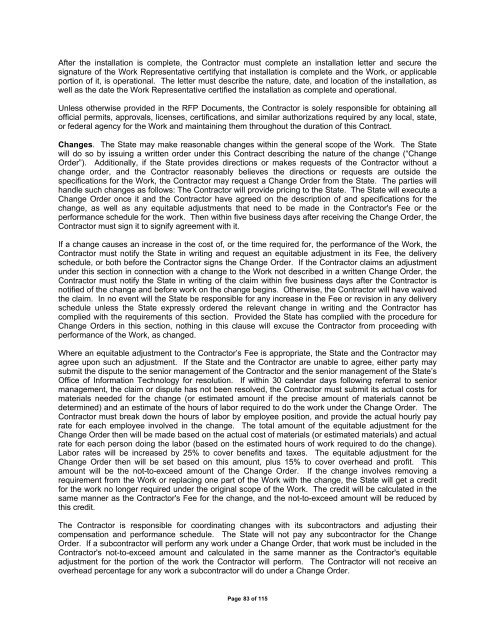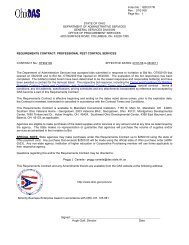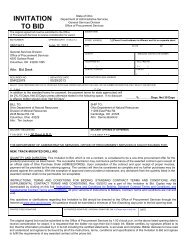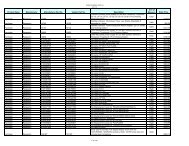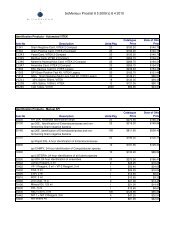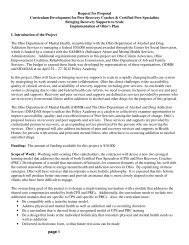REQUEST FOR PROPOSALS RFP NUMBER: 0A1031 DATE ISSUED
REQUEST FOR PROPOSALS RFP NUMBER: 0A1031 DATE ISSUED
REQUEST FOR PROPOSALS RFP NUMBER: 0A1031 DATE ISSUED
You also want an ePaper? Increase the reach of your titles
YUMPU automatically turns print PDFs into web optimized ePapers that Google loves.
After the installation is complete, the Contractor must complete an installation letter and secure the<br />
signature of the Work Representative certifying that installation is complete and the Work, or applicable<br />
portion of it, is operational. The letter must describe the nature, date, and location of the installation, as<br />
well as the date the Work Representative certified the installation as complete and operational.<br />
Unless otherwise provided in the <strong>RFP</strong> Documents, the Contractor is solely responsible for obtaining all<br />
official permits, approvals, licenses, certifications, and similar authorizations required by any local, state,<br />
or federal agency for the Work and maintaining them throughout the duration of this Contract.<br />
Changes. The State may make reasonable changes within the general scope of the Work. The State<br />
will do so by issuing a written order under this Contract describing the nature of the change (“Change<br />
Order”). Additionally, if the State provides directions or makes requests of the Contractor without a<br />
change order, and the Contractor reasonably believes the directions or requests are outside the<br />
specifications for the Work, the Contractor may request a Change Order from the State. The parties will<br />
handle such changes as follows: The Contractor will provide pricing to the State. The State will execute a<br />
Change Order once it and the Contractor have agreed on the description of and specifications for the<br />
change, as well as any equitable adjustments that need to be made in the Contractor's Fee or the<br />
performance schedule for the work. Then within five business days after receiving the Change Order, the<br />
Contractor must sign it to signify agreement with it.<br />
If a change causes an increase in the cost of, or the time required for, the performance of the Work, the<br />
Contractor must notify the State in writing and request an equitable adjustment in its Fee, the delivery<br />
schedule, or both before the Contractor signs the Change Order. If the Contractor claims an adjustment<br />
under this section in connection with a change to the Work not described in a written Change Order, the<br />
Contractor must notify the State in writing of the claim within five business days after the Contractor is<br />
notified of the change and before work on the change begins. Otherwise, the Contractor will have waived<br />
the claim. In no event will the State be responsible for any increase in the Fee or revision in any delivery<br />
schedule unless the State expressly ordered the relevant change in writing and the Contractor has<br />
complied with the requirements of this section. Provided the State has complied with the procedure for<br />
Change Orders in this section, nothing in this clause will excuse the Contractor from proceeding with<br />
performance of the Work, as changed.<br />
Where an equitable adjustment to the Contractor’s Fee is appropriate, the State and the Contractor may<br />
agree upon such an adjustment. If the State and the Contractor are unable to agree, either party may<br />
submit the dispute to the senior management of the Contractor and the senior management of the State’s<br />
Office of Information Technology for resolution. If within 30 calendar days following referral to senior<br />
management, the claim or dispute has not been resolved, the Contractor must submit its actual costs for<br />
materials needed for the change (or estimated amount if the precise amount of materials cannot be<br />
determined) and an estimate of the hours of labor required to do the work under the Change Order. The<br />
Contractor must break down the hours of labor by employee position, and provide the actual hourly pay<br />
rate for each employee involved in the change. The total amount of the equitable adjustment for the<br />
Change Order then will be made based on the actual cost of materials (or estimated materials) and actual<br />
rate for each person doing the labor (based on the estimated hours of work required to do the change).<br />
Labor rates will be increased by 25% to cover benefits and taxes. The equitable adjustment for the<br />
Change Order then will be set based on this amount, plus 15% to cover overhead and profit. This<br />
amount will be the not-to-exceed amount of the Change Order. If the change involves removing a<br />
requirement from the Work or replacing one part of the Work with the change, the State will get a credit<br />
for the work no longer required under the original scope of the Work. The credit will be calculated in the<br />
same manner as the Contractor's Fee for the change, and the not-to-exceed amount will be reduced by<br />
this credit.<br />
The Contractor is responsible for coordinating changes with its subcontractors and adjusting their<br />
compensation and performance schedule. The State will not pay any subcontractor for the Change<br />
Order. If a subcontractor will perform any work under a Change Order, that work must be included in the<br />
Contractor's not-to-exceed amount and calculated in the same manner as the Contractor's equitable<br />
adjustment for the portion of the work the Contractor will perform. The Contractor will not receive an<br />
overhead percentage for any work a subcontractor will do under a Change Order.<br />
Page 83 of 115


